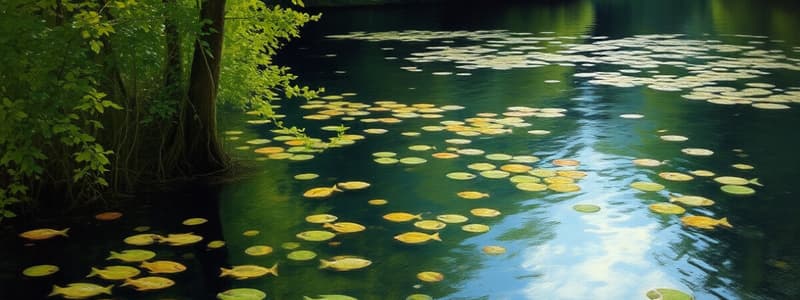Podcast
Questions and Answers
What is often considered the root cause of habitat alteration?
What is often considered the root cause of habitat alteration?
- World population growth and associated development (correct)
- Climate change
- Animal migration patterns
- Natural disasters
Which of the following is a way fish habitat can be lost?
Which of the following is a way fish habitat can be lost?
- Stable water temperatures
- Drying up or flooding at inappropriate times (correct)
- Increased sunlight
- Higher oxygen levels
What does sedimentation do to a habitat?
What does sedimentation do to a habitat?
- Stabilizes water temperature
- Cleans pollutants
- Increases oxygen levels
- Fills the habitat with dirt and debris (correct)
Which of the following describes eutrophication?
Which of the following describes eutrophication?
Which of the following is a major causes of decline in native fish species?
Which of the following is a major causes of decline in native fish species?
The destruction or modification of habitats is known as:
The destruction or modification of habitats is known as:
Deforestation of lake basins can lead to which of the following?
Deforestation of lake basins can lead to which of the following?
What can the draining and filling of marshes and isolation of wetlands impact?
What can the draining and filling of marshes and isolation of wetlands impact?
What does heavy logging near streams do?
What does heavy logging near streams do?
What do riparian buffers do for water quality?
What do riparian buffers do for water quality?
Livestock grazing in zones does what to turbidity and sedimentation?
Livestock grazing in zones does what to turbidity and sedimentation?
What does increasing sediment do to spawning areas?
What does increasing sediment do to spawning areas?
What does channelization do to streams?
What does channelization do to streams?
Roads built over streams can:
Roads built over streams can:
What problem frequently occurs in estuary environments?
What problem frequently occurs in estuary environments?
What impact do dams have on rivers?
What impact do dams have on rivers?
What is the ecological function of riparian zones?
What is the ecological function of riparian zones?
What is a solution to improve habitat?
What is a solution to improve habitat?
What is a stream restoration method?
What is a stream restoration method?
What is science and management with restoration need to be?
What is science and management with restoration need to be?
Flashcards
Sediment entry into streams
Sediment entry into streams
Entry of sediment into streams that degrades water quality and aquatic habitats.
Dams impact on rivers
Dams impact on rivers
Alteration of flow patterns and water temperatures in rivers by dams, leading to fish kills.
Habitat fragmentation
Habitat fragmentation
Discontinuities in an organism's preferred environment, leading to population fragmentation and species decline.
Watershed development impact
Watershed development impact
Signup and view all the flashcards
Riparian zones
Riparian zones
Signup and view all the flashcards
Ecological functions of riparian buffer zones
Ecological functions of riparian buffer zones
Signup and view all the flashcards
Solutions for habitat conservation
Solutions for habitat conservation
Signup and view all the flashcards
Major causes of fish species decline
Major causes of fish species decline
Signup and view all the flashcards
Sedimentation
Sedimentation
Signup and view all the flashcards
Water level problems
Water level problems
Signup and view all the flashcards
Deforestation of lake basins
Deforestation of lake basins
Signup and view all the flashcards
Heavy logging
Heavy logging
Signup and view all the flashcards
Livestock grazing
Livestock grazing
Signup and view all the flashcards
Channelization
Channelization
Signup and view all the flashcards
Study Notes
- Root cause of habitat alteration is world population growth, development, and urbanization.
- Habitat alteration is a major factor contributing to the decline of native fish species in North America and plays a role in fish biodiversity crises.
How Fish Habitat Can Be Lost
- Drying up or flooding can inappropriately affect habitat.
- Sedimentation can fill the habitat with dirt and debris.
- Vegetation or debris can block access and reduce habitat quality.
- Toxicants can contaminate and make the habitat unsafe for fish.
- Eutrophication or deoxygenation can lead to oxygen depletion and poor water quality.
- Structural damage or removal can cause destruction or homogenization of natural habitat features.
Major Causes of Decline in Native Fish Species
- Physical habitat alteration results in destruction or modification of habitats.
- Introduced/invasive species compete on native fish.
- Chemical alteration, contamination, or pollution results from chemicals, including nutrient loading.
- Overharvesting involves unsustainable exploitation of fish populations
- Chemical alteration can be grouped into physical.
Habitat Issues: Lakes
- Deforestation raises temp turbidity and organic input.
- Draining and filling of marshes and isolation of wetlands harm lakes.
- Lakes are often found in close proximity to filter water and maintain the water.
- Blockage of tributary streams is an issue.
- Dredging of harbors and channels is an issue.
Rivers and Streams
- Deforestation of river basin leads to habitat loss.
- Heavy logging near streams increases stream temps, stressing ecosystems.
- Insufficient riparian buffers will affect water quality, habitat, and stream ecosystems.
Additional Problems
- Livestock grazing increases turbidity and sedimentation, affecting water quality.
- Sediment destroys spawning areas for species relying on clean, gravelly streambeds.
- Channelization removes natural bends in streams to create uniform, straight channels and loss of deep pools where fish find refuge and natural habitats where fish hide or wait for food.
- Channelization is typically done for navigation or flood reduction.
- Roads built over streams can lead to habitat degradation.
Studying That Suits You
Use AI to generate personalized quizzes and flashcards to suit your learning preferences.





